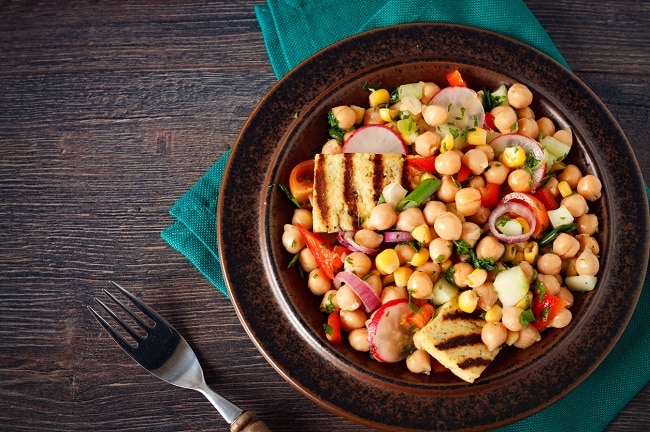March is National Nutrition Month. With 31 days dedicated to nutrition, you may begin to wonder about your own diet and how you could make healthier choices. Ask a dietitian what determines a nutritious diet for the average person, and they’ll probably talk about MyPlate. MyPlate is the United States Department of Agriculture’s (USDA) illustration of a balanced meal. But what if your doctor suggested the Mediterranean Diet for weight loss, or you’ve chosen to follow a vegan lifestyle with plant-based foods? Grab your fork. There’s a plate for everyone!
About MyPlate
Since March is National Nutrition Month, this is a good time to re-learn what MyPlate is and what it looks like. MyPlate divides a standard nine-inch plate into four sections, with dairy on the side to include all five food groups. It depicts the proper portions of a meal: half of the plate should be fruits and vegetables, about a quarter should be from grains, the other quarter from protein and a serving of dairy or other calcium-rich food incorporated onto your plate or as a side dish. Some meals will not divide so neatly, so keep the same proportions in mind when creating a meal or looking at an ingredient list. Aim for at least three food groups every time you sit down to eat, with one of them being a fruit or vegetable.
Many people may be able to follow these standard guidelines and see great results with their overall health and wellness. But if you have unique dietary needs, your body will respond much better to a custom-catered plate. Here are five variations that may help you get started:
MyPlate for Plant-Based Diets
For those who do not eat meat, poultry or fish on a regular basis, you’ll count beans and peas in the protein group. Other plant-based protein sources include tofu, tempeh, nuts and seeds.
Your Meal: Meatless Tacos
- Vegetables: slice and sautée onions, bell peppers and zucchini; season with garlic, cumin and chili powder
- Protein: add seasoned black beans
- Grains: use corn or whole wheat tortillas as your base
- Fruit: top with pineapple salsa for extra flavor
- Dairy: serve with a cup of almond or soy milk if vegan; lacto-vegetarians may add cheese of their choosing
Craving dessert? A freshly peeled orange or cup of mango slices will complement the taco flavors during or after your meal.
MyPlate for Celiac Disease or Gluten Sensitivity
If you have been diagnosed with celiac disease or have a gluten sensitivity, avoiding this wheat protein component can prevent extremely uncomfortable reactions. With so many whole foods naturally gluten-free, building a healthy plate is actually simpler than you think.
Your Meal: Homemade Lasagna
- Vegetables: pasta sauce counts toward your veggies, but also add 2 cups of spinach as a side salad and top it with slivered almonds and your favorite gluten-free dressing
- Protein: layer in lean ground beef or turkey
- Grains: use brown rice lasagna noodles and you’ll check off protein and grains in one
- Dairy: don’t forget the cheese!
Craving dessert? Enjoy a ripe pear to end the meal with something naturally sweet. Plus, you’ll knock out all five food groups!
MyPlate for Cholesterol Control
Trying to cut back on saturated fat to control healthy cholesterol levels? If so, you may not think a classic chili recipe could make the cut. This is how you can have your cup and eat it, too.
Your Meal: Classic Chili
- Vegetables: in addition to the tomatoes or tomato sauce you’ll use, add diced zucchini and/or mushrooms
- Protein: use half as much ground beef as the recipe calls for and rely on those veggies to bulk up the bowl; beans and peas can also serve as protein and may even count toward your vegetable tally
- Grains: add brown rice or red quinoa for carbohydrates and more protein
MyPlate for High Blood Pressure
Dietary Approach to Stop Hypertension (DASH) is an eating plan designed to lower or control high blood pressure. Main staples of the DASH diet are foods low in sodium and rich in potassium, magnesium and calcium. Red meats, sweet treats and sugary beverages are avoided as much as possible.
Your Meal: Baked Cod with Veggies
- Vegetables: steam 1 cup of fresh green beans or roast your favorite greens, such as Brussels sprouts
- Protein: bake 3-4 ounces of lemon-seasoned cod
- Grains: make a bed for your fish with about 1/2 cup of seasoned brown rice
- Fruit: add a side of mixed berries – about 1 cup will do
- Dairy: sip on low-fat milk to get enough calcium
MyPlate for Diabetes or Weight Loss
The Mediterranean Diet (often called Med Diet) focuses on staples from the Mediterranean countries, as these foods have shown to help improve brain function, prevent type 2 diabetes, fight certain cancers, lower the risk of heart disease and aid weight loss. Typically, Med Diet plans consist of vegetables, fruits, some dairy, seafood twice a week and some plant-based meals. The Med Diet limits large portions of meat, unsaturated fats and whole grains.
Your Meal: Greek Garbanzo Bean Salad
- Vegetables: in this mixed bowl, you’ll add cherry tomatoes, cucumbers and red onions
- Protein: garbanzo beans are the protein stars of the salad; stir those in
- Dairy/Fats: top it all off with feta cheese and a light red wine vinegar dressing
- Grains: stuff the mixture into a whole wheat pita, if desired
Craving dessert? An apple helps round out this health-conscious meal.
Regardless of current dietary guidelines or no guidelines at all, it’s important to always eat a variety of foods from all the food groups. Be creative with your food. Most importantly, enjoy what you eat. Healthy food can – and should be – delicious. Happy National Nutrition Month!


